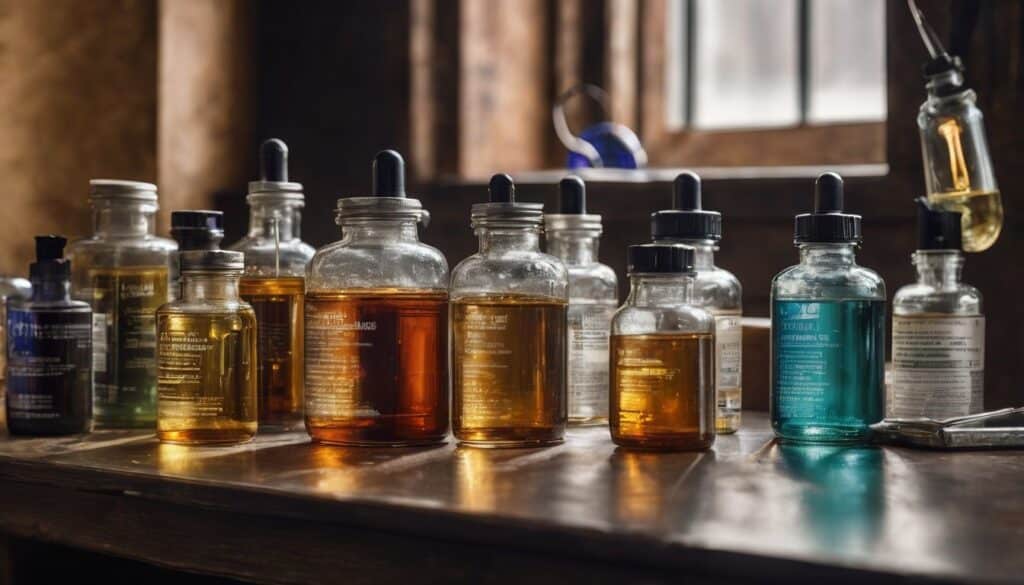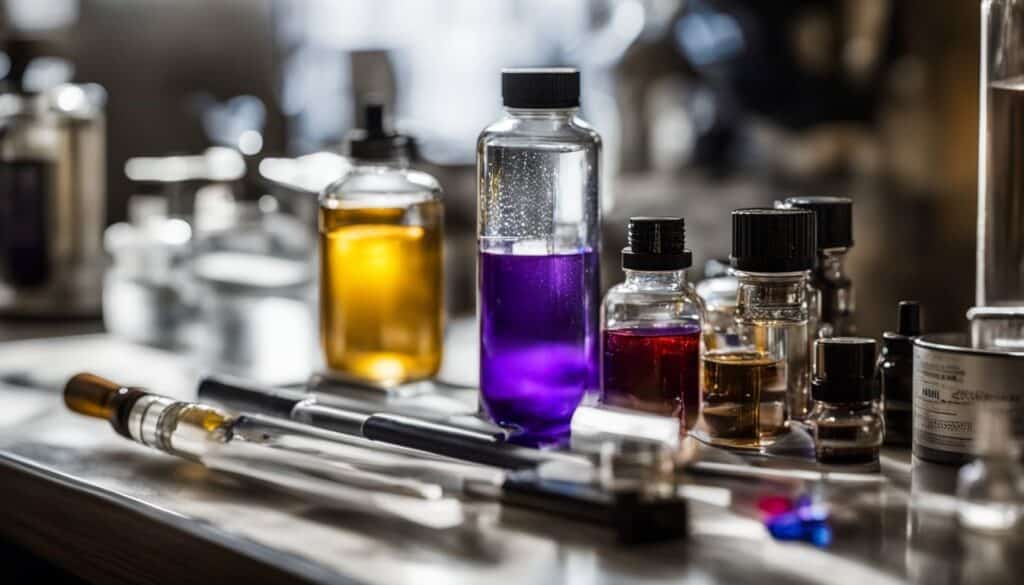Understanding The Different Types Of Colloidal Silver

Navigating the world of health supplements can be tricky, especially regarding products like colloidal silver. This powerful substance has been revered for its potential health benefits, sparking curiosity and confusion among consumers.
Our comprehensive guide will clarify the various types of colloidal silver available, their unique properties, and how they might benefit your wellness regime. Let’s unveil the silver secrets!
Key Takeaways
-
- Colloidal silver comes in three main types: atomic, ionic, and hydrosol silver. Each one has its features and benefits.
-
- Atomic (colloidal) silver is tiny metal bits in liquid that can fight germs. Ionic silver has charged particles fully mixed with water. Hydrosol is a blend of both particles and ions.
-
- The FDA doesn’t say colloidal silver is safe to eat for health problems. Too much can change skin color to bluish-gray.
-
- Choosing the right type depends on what you want it for, concerns about safety, and personal beliefs about how well it works.
-
- Particle size matters because smaller ones might work better against bacteria, but safety and rules are also important to consider when picking a product.
Types of Colloidal Silver

Colloidal silver comes in different forms, including atomic silver (colloidal), ionic silver, and hydrosol silver. Each type has unique properties and benefits that cater to different preferences and health needs.
Atomic Silver (Colloidal)
Atomic silver, or colloidal silver, is a liquid with tiny silver particles floating in it. These particles are really small bits of pure silver. People have found that atomic silver can fight germs.
In the 1980s, doctors at UCLA Medical School saw how it killed tiny bad bugs.
This kind of silver comes as a dietary supplement, too. It can look like clear water or a bit yellowish. Atomic silver has different names on the market, but they all mean it contains little pieces of metal floating around in the liquid without melting.
When you hear about “true colloidal silver,” that’s another way to say atomic silver. This type does not have other stuff mixed in – just water and those tiny flecks of pure metal.
Some folks use this when they want to keep healthy because they trust its power against microbes.
Ionic Silver
Ionic silver is different from other silver products because it does not have particles floating in liquid. Instead, it has silver ions. These tiny bits of silver have lost an electron and now have a positive charge.
This charged form of silver can mix completely with water to make a clear solution.
People use ionic silver, thinking it helps their health. Many makers call this product “monatomic silver” or “silver hydrosol.” They use these words instead of the scientific term ‘ionic silver.’
The big thing to know about ionic solutions is they only contain dissolved ions of silver, no actual solid particles.
Hydrosol Silver
Hydrosol silver stands out among silver solutions. It’s often seen near other colloidal silvers but quite different. This type of silver mixes tiny silver bits and charged particles called ions.
People call this bio-active silver hydrosol because it has both parts in pure water.
You won’t find big chunks of metal in hydrosol silver. Instead, these little bits work together to help keep you healthy. Many folks choose hydrosol silver for its fine particle size and high quality.
They believe it can help their body without using too much at once. Look for labels like “sovereign silver” or “silver protein”; these might be other names for similar products.
Differences Between Colloidal and Ionic Silver

Colloidal silver contains particles of metallic silver suspended in a liquid, while ionic silver consists of positively charged silver ions. The particle size, effectiveness against bacteria, and regulations for human consumption are key factors that distinguish these two types of silver.
Particle size
Colloidal silver particles are larger, staying suspended in the liquid base. The metallic silver particles in colloidal silver have a specific dimension within a certain size range.
These negatively charged particles distinguish colloidal silver from ionic silver, which contains positively charged ions rather than metal particles.
Colloidal and ionic silver particle size plays a crucial role in their behavior and effectiveness. Understanding this difference can help individuals make informed choices when considering these products for potential health benefits.
Effectiveness against bacteria
Colloidal silver, particularly silver nanoparticles, has shown strong antimicrobial effects. These tiny silver particles have been used in various medical and consumer products to fight against harmful bacteria.
Research demonstrates their effectiveness in inhibiting the growth of a wide range of bacterial strains, showcasing their potential as a natural antibacterial agent.
The small size of these silver particles allows them to interact more readily with bacteria, interfering with their cellular processes and ultimately leading to their destruction. This makes colloidal silver an intriguing option for those seeking natural solutions to combat bacteria and promote better health.
Human consumption and regulation
When considering colloidal silver for human consumption, it’s crucial to be aware of the regulations regarding its use. The Food and Drug Administration (FDA) has not approved colloidal silver as a safe or effective treatment for any health condition.
Excessive consumption can lead to argyria, turning the skin bluish-gray. Therefore, consulting with a healthcare professional before using colloidal silver as a dietary supplement is essential.
Furthermore, it is important to note that the safety and efficacy of colloidal silver are subjects of discussion among experts. According to a fact sheet from reputable sources, consuming products containing colloidal silver may not have clear benefits. It could pose risks to health due to potential adverse effects like argyria.
Choosing the Right Type of Colloidal Silver
When selecting the right type of colloidal silver, understanding the benefits of each type and considering personal preferences is essential for making an informed decision.
For a comprehensive guide on the different types of colloidal silver and their benefits, read on to learn more about this valuable health supplement.
Benefits of each type
Atomic Silver (Colloidal): Made of tiny silver particles suspended in a liquid, atomic silver is known for its antimicrobial activity and potential wound-healing properties. With low particle size and high ionic content, this type of colloidal silver may be effective against various bacteria and viruses.
Ionic Silver: Composed of positively charged silver ions dissolved in the solution, ionic silver solutions are typically clear. While it may not necessarily contain silver particulates, the high ionic content contributes to its antimicrobial effectiveness.
However, it’s important to note that some argue about its comparative benefits.
Hydrosol Silver: This mixture mainly consists of silver ions rather than particulates but still has known benefits for several health conditions due to the presence of active species of silver.
Personal preferences
When choosing a colloidal silver product, personal preferences play a crucial role. Some may prefer atomic silver for its smaller particle size and potential effectiveness against bacteria, while others might lean towards ionic silver for its different benefits.
Consider the concentration of silver, the intended use, and individual beliefs when selecting the best type of colloidal silver that aligns with personal preferences.
It’s important to weigh personal preferences when deciding which form of colloidal or ionic silver to use. Factors such as safety concerns, regulatory considerations, and even taste can influence the choice between these types of products.
FAQs
Q: What is colloidal silver?
A: Colloidal silver is a suspension of silver particles in a liquid, typically water. It is often used as a dietary supplement and is known for its antimicrobial effects.
Q: What are the different types of colloidal silver products?
A: The three main types of colloidal silver are true colloidal silver, ionic silver solutions, and silver protein solutions. Each type varies in the size and form of silver particles and how they are suspended in the solution.
Q: What is the difference between true colloidal and ionic silver solutions?
A: True colloidal silver contains silver nanoparticles uniformly suspended in the liquid, while ionic silver solutions contain silver ions dissolved in the liquid. The former is generally considered more effective due to silver particles.
Q: What are the benefits of using colloidal silver?
A: Colloidal silver is believed to have antimicrobial properties and is used for various health purposes. It is also used for topical applications such as wound care and to support the immune system.
Q: Are there any risks associated with using colloidal silver?
A: Excessive use of colloidal silver can lead to a condition called argyria, which causes the skin to turn blue-gray. It is important to use colloidal silver products according to recommended guidelines.
Q: How can I identify a true colloidal silver product?
A: True colloidal silver will typically have a higher concentration of silver nanoparticles, resulting in a more opaque appearance. Unlike other silver products on the market, it does not contain large protein molecules or silver ions.
Q: What are the different forms of silver marketed as colloidal silver?
A: Silver marketed as colloidal silver may come in various forms, including colloidal silver and ionic silver solutions, silver hydrosols, silver nanoparticles, and bioactive silver hydrosols.
Q: Can colloidal silver be used as a dietary supplement?
A: Yes, colloidal silver is often marketed as a dietary supplement, although its use and efficacy are areas of debate within the medical and scientific communities.
Q: How does colloidal silver work as an antimicrobial agent?
A: Colloidal silver is believed to work by damaging the cell walls of bacteria, viruses, and other microorganisms, thereby inhibiting their growth and replication.
Q: Are there any regulations governing the sale of colloidal silver products?
A: In some countries, there are regulations and restrictions on the sale of colloidal silver products due to concerns about its safety and efficacy. It is important to consult with healthcare professionals before using colloidal silver as a health supplement.

